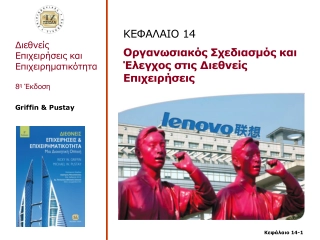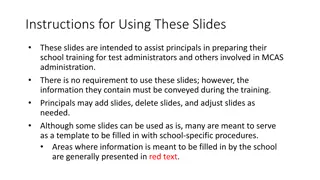
Efficient Exhaustive Testing with Symbolic.ns-3 for Network Protocols
Explore how Symbolic.ns-3 enhances exhaustive testing efficiency in network protocols through a detailed design, implementation, and simulations approach. Learn the benefits, working mechanism, and strategies to optimize Symbolic.ns-3 for comprehensive testing. Witness the comparison of Symbolic.ns-3 with traditional methods, showcasing significant speed improvements and accuracy in detecting bugs and worst-case scenarios.
Download Presentation

Please find below an Image/Link to download the presentation.
The content on the website is provided AS IS for your information and personal use only. It may not be sold, licensed, or shared on other websites without obtaining consent from the author. If you encounter any issues during the download, it is possible that the publisher has removed the file from their server.
You are allowed to download the files provided on this website for personal or commercial use, subject to the condition that they are used lawfully. All files are the property of their respective owners.
The content on the website is provided AS IS for your information and personal use only. It may not be sold, licensed, or shared on other websites without obtaining consent from the author.
E N D
Presentation Transcript
Symbolic ns-3 for Efficient Exhaustive Testing: Design, Implementation, and Simulations Jianfei Shao, Minh Vu, Mingrui Zhang, Asmita Jayswal, Lisong Xu School of Computing, University of Nebraska-Lincoln https://symbolicns3.github.io
Outline Why Symbolic ns-3 (sym-ns-3)? How it works? How to make it more efficient? Conclusions
Exhaustive Testing What is it? Exhaustively test something (protocol/network) for all possible cases When do we need it? Evaluate all possible performance of a protocol/network Find the worst-case performance of a protocol/network Detect the bugs of a protocol/network
Exhaustive Testing Example 1 Two senders each sends a packet to the receiver simultaneously pkt0 pkt1 rcv snd0 snd1 delay d0 delay d1 Problem: What are all possible arrival time differences? Measurement: diff = Arrival time of pkt0 arrival time of pkt1 All possible link delays d0 [1, 1000] ms d1 [1, 1000] ms
pkt0 pkt1 rcv snd0 snd1 d0 [1, 1000] d1 [1, 1000] Using ns-3 How to find all possible diff values? ns-3 script simulates the network for a specific (d0, d1) and reports diff shell script runs the ns-3 script for all possible (d0, d1) Simulation result All reported diff values = [-999, 999] ms Simulation time The simulation time for one (d0, d1) 0.5 seconds Total number of (d0, d1) = 1000 x 1000 = 1,000,000 Total simulation time for all possible (d0, d1) 6 days Exhaustive testing is time-consuming with ns-3!
pkt0 pkt1 rcv snd0 snd1 d0 [1, 1000] d1 [1, 1000] Using Our sym-ns-3 How to find all possible diff values? sym-ns-3 script simulates the network for a symbolic (d0, d1) and reports diff Simulation result All reported diff values = [-999, 999] ms Same simulation results as ns-3 Simulation time The simulation time for a symbolic (d0, d1) 1 minute Significantly faster than ns-3 sym-ns-3 is more efficient for exhaustive testing than ns-3
Outline Why sym-ns-3? How it works? How to make it more efficient? Conclusions
sym-ns-3 Goal Efficient exhaustive testing How? Based on symbolic execution Simulates a group of equivalent cases together instead of each case separately
Background on Symbolic Execution A variable may have a symbolic value (a set of values specified by constraints) instead of only a specific value. When a program is executed symbolically, both branches instead of one branch of an if statement are explored. Pseudocode example Execution tree initial constraints 1<= d0 <= 1000 1<= d1 <= 1000 1. sym 1<= d0 <= 1000 2. sym 1<= d1 <= 1000 3. if (d0 > d1){ 4. // simulate accordingly 5. diff = d0 d1; 6. } else { 7. // simulate accordingly 8. diff = d0 d1; 9. } no yes d0 > d1 final constraints 1<= d0 <= 1000 1<= d1 <= 1000 d0 > d1 simulation result diff [1, 999] final constraints 1<= d0 <= 1000 1<= d1 <= 1000 d0 <= d1 simulation result diff [-999, 0]
Branches Branch 1 All the equivalent cases following the same red execution path Branch 2 All the equivalent cases following the same green execution path Symbolic execution runs equivalent cases together as branches, and thus is more efficient for exhaustive testing. Execution tree initial constraints 1<= d0 <= 1000 1<= d1 <= 1000 no yes 1. 2. 3. 4. 5. 6. 7. 8. 9. sym 1<= d0 <= 1000 sym 1<= d1 <= 1000 if (d0 > d1){ // simulate accordingly diff = d0 d1; } else { // simulate accordingly diff = d0 d1; } 1. 2. 3. 4. 5. 6. 7. 8. 9. sym 1<= d0 <= 1000 sym 1<= d1 <= 1000 if (d0 > d1){ // simulate accordingly diff = d0 d1; } else { // simulate accordingly diff = d0 d1; } d0 > d1 final constraints 1<= d0 <= 1000 1<= d1 <= 1000 d0 > d1 simulation result diff [1, 999] Branch 1 final constraints 1<= d0 <= 1000 1<= d1 <= 1000 d0 <= d1 simulation result diff [-999, 0] Branch 2
How sym-ns-3 modifies ns-3? Have explored three different methods to modify ns-3 Currently choose method 3 Future, both methods 2 and 3 variables variables management functions management functions Symbolic Class Symbolic Class attributes attributes attributes + new attributes + new variables functions variables variables variables functions modified functions modified functions new variables management functions sym-ns-3 module Symbolic Class variable ns-3 module sym-ns-3 module sym-ns-3 module Method 1 Method 2 Method 3 more functionalities less development
Example 1 scripts of ns3 vs sym-ns-3 pkt0 pkt1 rcv snd0 snd1 d0 [1, 1000] d1 [1, 1000] ... // Other setup code ... // Other setup code Symbolic Class Ptr<Symbolic> sym0 = CreateObject<Symbolic>(); sym0->SetMinMax(1, 1000); uint32_t d0 = sym0->GetSymbolicUintValue(); p2p[0].SetChannelAttribute("Delay",TimeValue(Time(d0))); a symbolic management function uint32_t d0 = 1; p2p[0].SetChannelAttribute("Delay",TimeValue(Time(d0))); get symbolic value use existing attribute Ptr<Symbolic> sym1 = CreateObject<Symbolic>(); sym1->SetMinMax(1, 1000); uint32_t d1 = sym1->GetSymbolicUintValue(); p2p[1].SetChannelAttribute("Delay",TimeValue(Time(d1))); uint32_t d1 = 1; p2p[1].SetChannelAttribute("Delay",TimeValue(Time(d1))); ... // Simulation execution sym-ns-3 script (method 3) ... // Simulation execution ns-3 script
Exhaustive Testing Example 2 TCP Performance Problem: Find all possible performance of TCP delay d0 snd rcv delay d1 All possible network delays Forward delay: d0 [1, 1000] ms Backward delay: d1 [1, 1000] ms Measurement: Number of received data packets in 2000 ms Limit the max number of data packets to 2 in order to manually check the simulation results
d0 [1, 1000] snd rcv Results d1 [1, 1000] ns-3 Take about 6 days to run 1000x1000 (d0, d1) cases, each about 0.5 seconds sym-ns-3 Take about 3 hours and explore about 140 branches for symbolic (d0, d1) Simulation result summary 2d0 + d1 3d0 + 2d1 (3-way handshake + 1 RTT) Num of received data packets Comments (3-way handshake) [1999, 3000] [2999, 5000] 0 long three-way handshake Takes only about 3 hours for 1 millions of TCP tests [1000, 1998] [1999, 3497] 1 just enough time to transmit one data packet [3, 1331] [5, 1998] 2 otherwise
Exhaustive Testing Example 3 IP Reachability Problem: Find all 10.x.x.x addresses reachable from node 0 using ping ping
Simulation Times ping ns-3 Take about 100 days to run 256x256x256 = 16,777,216 cases (10.x.x.x), each about 0.5 seconds sym-ns-3 Take about 15 minutes and explore about 30 branches for symbolic IP destination 10.x.x.x Necessary to check each IP to detect all possible bugs
Reported Ping RTTs ping Destination IP Ping RTT (ms) 10.1.0.1 0 10.1.0.2, 10.1.255.255, 10.2.0.1, 10.2.255.255, 10.3.0.1, 10.3.255.255, 10.4.0.1, 10.4.255.255 10 10.2.0.2, 10.5.0.1, 10.5.255.255 70 Takes only about 15 minutes for 16 millions of ping tests 10.5.0.2 72 10.3.0.2, 10.6.0.1, 10.6.255.255 110 10.6.0.2 116 10.4.0.2, 10.7.0.1, 10.7.255.255 150 10.7.0.2 164 Others No reply for ping
Outline Why sym-ns-3? How it works? How to make it more efficient? Conclusions
Making sym-ns-3 More Efficient Notice we can make sym-ns-3 even more efficient Goal: Reduce the number of branches How? Redesign and rewrite simulator so that different cases share the same execution path as much as possible So far, we have redesigned and rewritten ns-3 event schedulers (ACM Transactions on Modeling and Computer Simulation 2022) ns-3 routers (this WNS3 paper)
Redesign IP Routers Redesign the code that compares symbolic IP addresses Details in our WNS3 paper Illustrating example - find the interface for a destination IP (dst) original code: 5 branches (num of entries) rewritten code: 3 branches (num of interfaces), keeping same simulation results original code rewritten code entry1 entry2 if (dst matches entry1) //branch 1 return interface1 else if (dst matches entry2) //branch 2 return interface1 else if (dst matches entry3) //branch 3 return interface2 else if (dst matches entry4) //branch 4 return interface2 else //branch 5 return interface0 if (dst matches entry1 or entry2) //branch 1 return interface1 else if (dst matches entry3 or entry4) //branch 2 return interface2 else //branch 3 return interface0 entry1 entry3 entry4 entry2 other entry3 entry4 other
Exhaustive Testing Example 3 IP reachability example Add multiple additional entries to routing table Rewritten code reduces the number of branches Destination Mask Interface 10.5.1.0 255.255.255.0 2 10.5.n.0 255.255.255.0 2 Additional entries to routing table of node 2
Outline Why sym-ns-3? How it works? How to make it more efficient? Conclusions
Conclusion sym-ns-3 for efficient exhaustive testing Future work Continue improving the efficiency More support for symbolic floating-point numbers Project webpage (code, documents): https://symbolicns3.github.io Acknowledgement: Supported in part by NSF-CCF-1918204
Running ns-3 vs sym-ns-3 sym-ns-3 Each branch is conceptually a virtual machine running a copy of sym-ns-3. Virtual Machine S2E symbolically executes big software systems https://github.com/S2E/s2e ns-3 Symbolic Execution Platform Operating System Operating System Running ns-3 Running sym-ns-3
Redesign Event Schedulers Redesign the code that compares symbolic event timestamps Details in ACM Transactions on Modeling and Computer Simulation 2022 Illustrating example - determine whether event e1 or e2 executes first original code: 3 branches rewritten code: 2 branches, while keeping same simulation results original code rewritten code if (e1.t <= e2.t) { //branch 1 // execute event e1 // execute event e2 } else { //branch 2 // execute event e2 // execute event e1 } if (e1.t < e2.t) { //branch 1 // execute event e1 // execute event e2 } else if (e1.t == e2.t) { //branch 2 // execute event e1 // execute event e2 } else { //branch 3 // execute event e2 // execute event e1 } befor esame time befor e same time after after






















